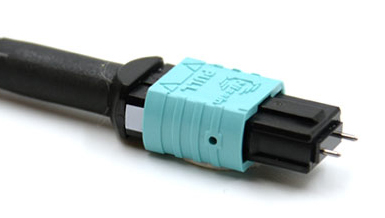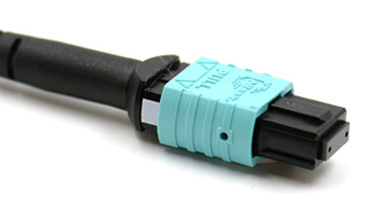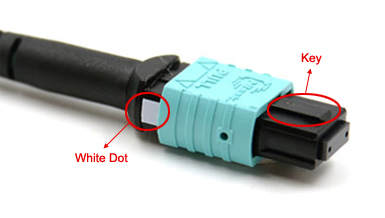MPO Gender
MPOs are
classified by the guide pins on the end of the connector, and require 1
male and 1 female to mate properly. MPO connectors use a “barrel sleeve”
adapter that simply holds one male and one female MPO “plug” together.
The male guide pins fit into the female holes to ensure precise fiber
alignment. Attempting to mate two female connectors will result in a
seemingly secure connection, but with extremely high loss, and
attempting to mate two male connectors will most likely damage one or
both connectors due to the guide pins clashing.
Transceivers and
cassettes come with the sleeve adapter built in, and the industry
standard is a male connection on the inside. Therefore, the standard for
cables is female to female. This changes, however, when you need to
extend a cable or connect two cables. You will then need a male to
female cable plus adapter. If you’re designing a multi-ferrule MPO trunk
backbone cable, you might consider making this male to male, then
patching to your hardware with female to female cables. We offer all
combinations of genders, so contact us with your needs and we will be
able to customize these for you.

|

|
|
MPO Male with Pins
|
MPO Female without Pins
|
Gender Standards
|
Cassettes
|
Male Port
|
|
Transceivers
|
Male Port
|
|
Patch Cables
|
Female to Female
|
|
Extender Cables
|
Male to Female
|
|
Trunk Cables
|
Male to Male (Custom Mix)
|
MPO Polarity
MPO connectors have a key on one of the flat sides added by the body,
and the orientation of this key determines the cable’s polarity. MPO
and MTP connectors also have a white dot on one side of the connector to
denote where pin 1 is.

Polarities



Please Note: When
it is connected with two 40G QSFP+ transceivers, please choose the
Method B as polarity; when it is connected with other equipment such as
MPO Cassettes, you can choose any of the polarities as you need.
Parameter Reference
|
Type
|
Singlemode (APC Polish)
|
Singlemode (PC Polish)
|
Multimode (PC Polish)
|
|
Fiber Count
|
8, 12, 24, etc.
|
8, 12, 24, etc.
|
8, 12, 24, etc.
|
|
Fiber Type
|
G652D, G657A1 etc.
|
G652D, G657A1 etc.
|
OM1, OM2, OM3 etc.
|
|
Maximum Inertion Loss
|
Elite
|
Standard
|
Elite
|
Standard
|
Elite
|
Standard
|
|
Low Loss
|
Low Loss
|
Low Loss
|
|
≤0.35 dB
|
≤0.75 dB
|
≤0.35 dB
|
≤0.75 dB
|
≤0.35 dB
|
≤0.60dB
|
|
Return Loss
|
≥55 dB
|
≥45 dB
|
≥20 dB
|
|
Durability
|
≥200 times
|
≥200 times
|
≥200 times
|
|
Operating Temperature
|
-10℃ ~ +70℃
|
-10℃ ~ +70℃
|
-10℃ ~ +70℃
|
|
Test Wavelength
|
1310nm
|
1310nm
|
850nm
|
Multimode Fiber Variants
While singlemode is optimized for long range data transfer,
multimodes are designed with high-bandwidth short range optimization in
mind. OM1 is a 62.5/125µm fiber core, with the jacket usually cladded in
orange. This is typically found in older applications where high
bandwidth isn’t a priority. OM2 is the first variant of 50/125µm,
usually also orange, but widely unused. OM2 offers modest improvement
over OM1, however OM3 is leaps and bounds ahead with not much more cost.
OM3 is a laser optimized variant of 50/125µm multimode, and is the
first fiber mode that supports 10Gb/40Gb/100Gb Ethernet. A recent
addition to the lineup is OM4, which offers a longer range than OM3. It
should be noted that OM3 and OM4 are cross-compatible, and while OM4 is
only needed for distances that exceed OM3 capabilities, it can still be
used for shorter connections.
|
Type
|
10 Gb
|
40 Gb
|
40 Gb (QSFP+ eSR4)
|
100 Gb (24 Fiber)
|
|
OM1
|
33m
|
N/A
|
N/A
|
N/A
|
|
OM2
|
82m
|
N/A
|
N/A
|
N/A
|
|
OM3
|
300m
|
100m
|
330m
|
100m
|
|
OM4
|
400m
|
150m
|
550m
|
150m
|
Applications
- Security networks
- Telecommunication networks
- Active device interface
- Data center networks
- Gigabit Ethernet
- Data processing networks
- Interconnection for O/E modules
- High density cross-connects
- Optical switch inter-frame connection